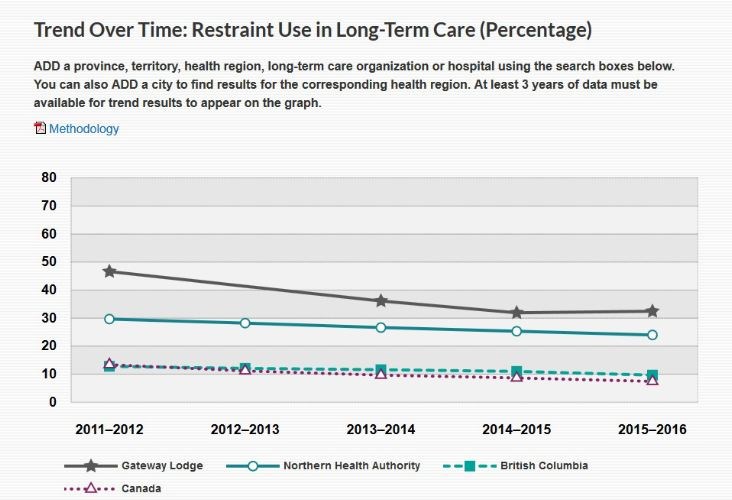The daily use of physical restraints in Northern Health's long term care facilities was more than three times higher than the Canadian average and more than double the B.C. average last year, according to a national report.
The Canadian Institute for Health Information (CIHI) said 24 per cent of residents in Northern Health facilities were physically restrained on a daily basis in 2015-2016. In B.C., 9.6 per cent of residents in long-term care were restrained daily while the national average sits at 7.4 per cent in 2015-2016.
Limb and trunk physical restraints are used in beds while there are also restraints used in chairs. These restraints are sometimes used to manage behaviours and prevent falls, said the CIHI report.
The percentage of patients being physically restrained on a daily basis in Northern Health has declined from 29.7 per cent in 2011-12 to 24 per cent in 2015-16.
Provincially, 12.8 of long-term care residents were restrained daily, declining to 9.6 per cent, while federal numbers in 2011-12 were at 13.4 and declined to 7.4 in 2015-16.
At Gateway Lodge in Prince George percentage of patients being physically restrained on a daily basis in 2011-2012 was 46.6 per cent, declining to 32.6 per cent in 2015-2016.
Meanwhile, Peace Villa in Fort St. John increased its use of daily restraints, from 35 per cent of residents in 2011-2012. Last year, it was at 40.1 per cent.
"We need to find out why is it so high," B.C. Seniors Advocate Isobel Mackenzie said.
"Sometimes they are not even reviewing the data so they don't even realize it's that high. Sometimes the first step is pointing that out. This is a concern to me now that it's been brought to my attention and I'm interested to know why."
In April 2016, the Vancouver Sun cited a report by the B.C. Seniors Advocate addressing the high numbers of daily use of physical restraints in long term care facilities. At that time, Northern Health spokesman Jonathon Dyck said they were taking the seniors advocates report very seriously and would investigate why the rates are so high.
"I am hopeful that the provincial government's recent commitment to increasing the care hours is going to help to address this because when you look at some of the reasons for restraint - not all of the reasons for restraint - they can be linked to low staffing levels," Mackenzie said.
"So when you're looking at bed restraints oftentimes that is because the person is perceived as being in danger of getting out of bed and we have monitors, we have alarms that will go off when someone rises out of bed but you have to be able to get in there quickly.
"So if you have low staffing, particularly at night, and you have a lot of people at risk for falls and cannot get out of bed unassisted you might restrain them at night - you shouldn't but you might and the reason you're doing that is because you're not confident that when the alarm rings to tell you they're out of bed or they are getting out of bed that you're going to be able to there in time."
A request for a response from Northern Health was made by The Citizen by email last Wednesday with a deadline of Thursday to respond.
Northern Health contacted The Citizen on Monday afternoon to say they may be ready speak to the CIHI numbers today.



